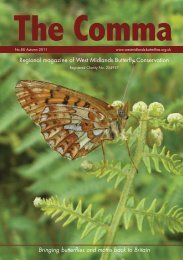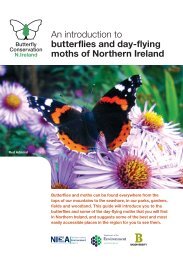EIG newsletter - Butterfly Conservation
EIG newsletter - Butterfly Conservation
EIG newsletter - Butterfly Conservation
You also want an ePaper? Increase the reach of your titles
YUMPU automatically turns print PDFs into web optimized ePapers that Google loves.
The Danube Clouded Yellow became rare in the 1970s in several locations where it was<br />
recorded as common earlier, and it probably became extinct from locations where it was not<br />
even recorded although probably occurred. For example the habitat of the Bakony Hills<br />
(Transdanubia) has transformed over time from forest-steppe landscape into closed forest and<br />
the butterfly has disappeared completely. At the end of the 1980s, there only remained a few<br />
areas where it was recorded regularly: the İrség and Vendvidék near the Austrian and<br />
Slovenian borders but it became extremely rare by the end of the 1990s.<br />
The trend seems to be the same in all other Central<br />
European countries. It has completely disappeared from<br />
southern Germany, where there were once rich<br />
populations inhabiting the warm slopes of the hills near<br />
Regensburg. None were recorded from Austria in the<br />
last 20 years and last record from Slovenia was in 1993.<br />
Only very few specimens were recorded in Hungary<br />
between 2000-2006 despite the intensive monitoring of<br />
the species, and also very few were seen in the White<br />
Typical C.Myrmidone habitat Photo: unknown<br />
Carpathians in Slovakia and Czech Republic.<br />
The reasons for this decrease is not fully understood, but one thing is clear, the change from<br />
traditional land use strengthened the process: firstly abandonment of large pasture fields and<br />
meadows helped the vegetation to grow high, and the pioneer-like Broom cannot stand the<br />
competition. Secondly after radical decreases in livestock keeping, large areas were no longer<br />
needed as source of hay, therefore they have been turned into arable crop fields. This not only<br />
destroyed large areas suitable for C. myrmidone, but also fragmented the habitat that was left.<br />
Thirdly the Central-European populations of Danube Clouded Yellow became completely<br />
isolated by large agricultural deserts from the Eastern-European ones. The migration between<br />
colonies has become almost impossible, which may have hastened the extinction of local<br />
colonies such as those in Bavaria.<br />
An investigation of the present day habitats in Hungary came to the conclusion that C.<br />
myrmidone cannot survive the changes in the habitat size, structure and loss of food plant<br />
together. The recognition of these problems means that all the efforts to protect the butterfly<br />
have come too late to save the species in Central Europe. The last inhabited regions in the<br />
İrség and Vendvidék cannot now be restored into their original pasture fields and structure<br />
without an international conservation project and huge investment of both work and money. The<br />
abundance of C. myrmidone is now extremely low, therefore the population needs more<br />
individuals to be introduced from another viable population, even if a complete landscape scale<br />
habitat restoration could be arranged.<br />
To examine the possibilities of saving Danube Clouded Yellow in Central Europe, a small group<br />
of experts was formed in early September 2006. They<br />
call themselves “Myrmidone Friends” and now they’re<br />
gathering information about the species from all available<br />
sources. They plan to visit different areas where C.<br />
myrmidone had once occurred and others where they still<br />
live happily with the traditional management of the land.<br />
One of the richest populations remaining in Europe is<br />
situated in Transylvania, Romania, which may be a future<br />
source of specimens for re-introduction of the species<br />
into Central Europe<br />
Sáfián Szabolcs<br />
16<br />
“Myrmidone Friends” in action<br />
Slovenian-Hungarian group is trying to find Danube Clouded Yellow in the<br />
Goricko National Park in Slovenia and İrség National Park in Hungary<br />
(from the left: Matjaž Jež, Rudi Verovnik, Kristjan Malačič, Attila Mesterházy,<br />
Szabolcs Sáfián) Photo: István Szentirmai







